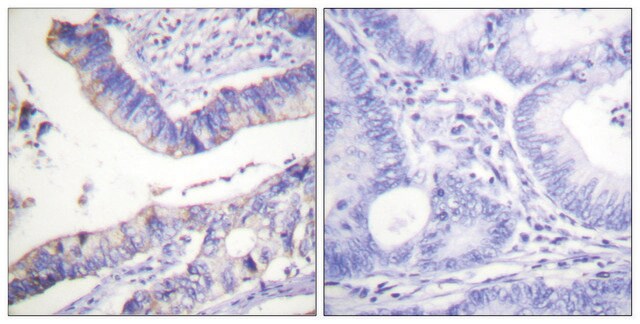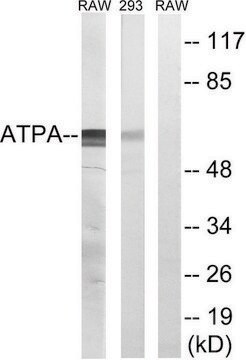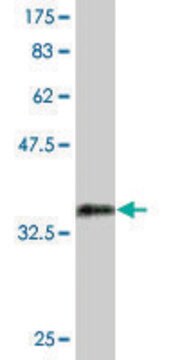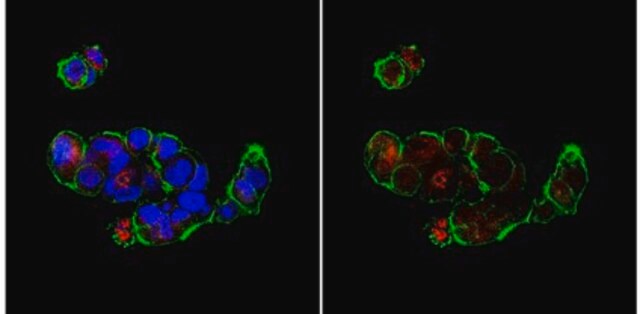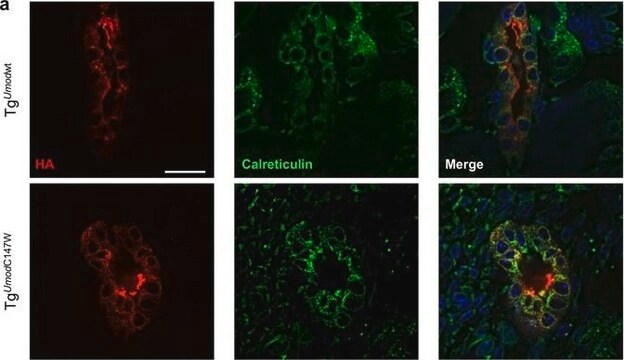MABF268
Anti-IRF3 Antibody, clone SL-12
clone SL-12, from mouse
Sinónimos:
Interferon regulatory factor 3, IRF-3
About This Item
Productos recomendados
origen biológico
mouse
Nivel de calidad
forma del anticuerpo
purified antibody
tipo de anticuerpo
primary antibodies
clon
SL-12, monoclonal
reactividad de especies
human, mouse
técnicas
immunocytochemistry: suitable
immunoprecipitation (IP): suitable
western blot: suitable
isotipo
IgG1κ
Nº de acceso NCBI
Nº de acceso UniProt
Condiciones de envío
wet ice
modificación del objetivo postraduccional
unmodified
Información sobre el gen
human ... IRF3(3661)
Descripción general
Inmunógeno
Aplicación
Immunoprecipitation Analysis: A representative lot immunoprecipitated IRF3 in HEC1B cells treated or untreated with virus and M059J DNA-PK - and M059J cells with DNA-PK+ (Karpova, A.Y., et al. (2002). PNAS. 99(5):2818-2823).
Western Blotting Analysis: A representative lot detected IRF3 in HFK (human foreskin keratinocytes) cells expressing BPV ORF′s (Ronco, L.V., et al. (1998) Genes Dev. 12:2061-2072).
Western Blotting Analysis: A representative lot detected IRF3 in Transfected Mock and SeV infected 293 cells (Basler, C.F., et al. (2003) Journal of Virology. 77(14):7945-7956).
Immunocytochemistry Analysis: A representative lot detected IRF3 in hec-1b cells infected with delNS1 or PR8 (Talon. J., et al. (2000). Journal of Virology. 74(17):7989-7996).
Immunocytochemistry Analysis: A representative lot detected IRF3 in HEC1B cells treated or untreated with virus (Karpova, A.Y., et al. (2002). PNAS. 99(5):2818-2823).
Inflammation & Immunology
Immunoglobulins & Immunology
Calidad
Western Blotting Analysis: 1.0 µg/mL of this antibody detected IRF3 in 10 µg of HeLa cell lysate.
Descripción de destino
Ligadura / enlace
Forma física
Almacenamiento y estabilidad
Otras notas
Cláusula de descargo de responsabilidad
¿No encuentra el producto adecuado?
Pruebe nuestro Herramienta de selección de productos.
Código de clase de almacenamiento
12 - Non Combustible Liquids
Clase de riesgo para el agua (WGK)
WGK 1
Punto de inflamabilidad (°F)
Not applicable
Punto de inflamabilidad (°C)
Not applicable
Certificados de análisis (COA)
Busque Certificados de análisis (COA) introduciendo el número de lote del producto. Los números de lote se encuentran en la etiqueta del producto después de las palabras «Lot» o «Batch»
¿Ya tiene este producto?
Encuentre la documentación para los productos que ha comprado recientemente en la Biblioteca de documentos.
Nuestro equipo de científicos tiene experiencia en todas las áreas de investigación: Ciencias de la vida, Ciencia de los materiales, Síntesis química, Cromatografía, Analítica y muchas otras.
Póngase en contacto con el Servicio técnico